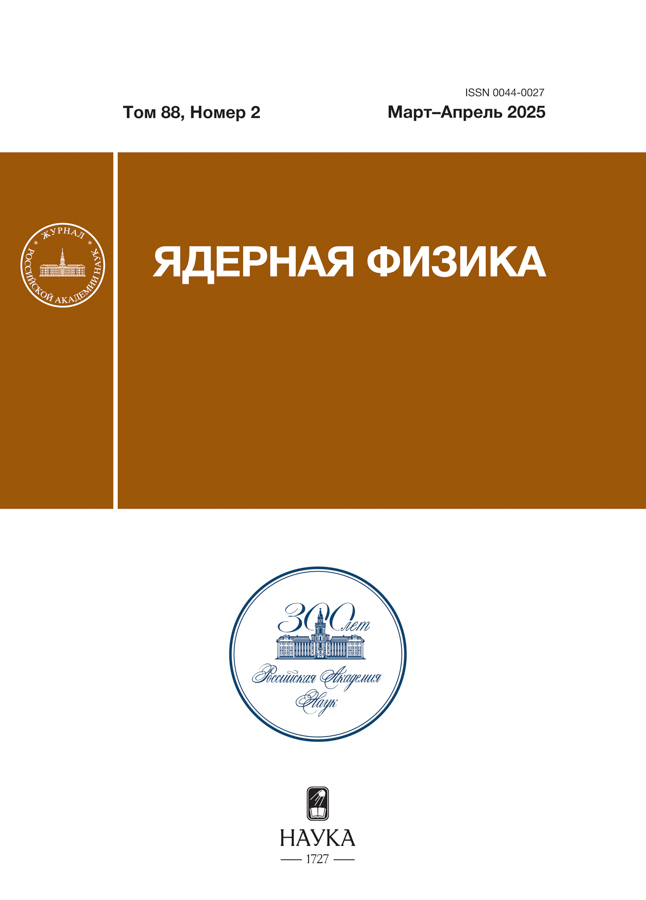О ВАЖНОСТИ УЧЕТА НАЧАЛЬНОЙ ПРОТЯЖЕННОСТИ РЕЛЯТИВИСТСКИХ СТРУН ПРИ МОДЕЛИРОВАНИИ ПРОЦЕССА АДРОНИЗАЦИИ
- Авторы: Николаенко Р.В.1
-
Учреждения:
- Национальный исследовательский ядерный университет “МИФИ”
- Выпуск: Том 87, № 3 (2024)
- Страницы: 205-211
- Раздел: ЭЛЕМЕНТАРНЫЕ ЧАСТИЦЫ И ПОЛЯ. Теория
- Статья опубликована: 15.06.2024
- URL: https://cardiosomatics.ru/0044-0027/article/view/674734
- DOI: https://doi.org/10.31857/S0044002724030109
- EDN: https://elibrary.ru/IWGSGA
- ID: 674734
Цитировать
Полный текст
Аннотация
Данные ряда экспериментов в физике высоких энергий указывают на трудности с описанием рождения пионов и ρ0-мезонов существующими моделями адронных взаимодействий. Одной из возможностей введения новых неколлективных эффектов является модернизация моделей фрагментации релятивистских струн Намбу–Гото. Как вариант предлагается использование начально-протяженных струн, что позволяет вычислять параметры струны в реалистичных для адронных и ядро-ядерных взаимодействий конфигурациях. Для этого вводится специальная калибровка, подходящая для расчета с произвольными начальными данными. Возможность определения спин-орбитальных характеристик струн позволяет накладывать дополнительные ограничения на массу струн-фрагментов.
Об авторах
Р. В. Николаенко
Национальный исследовательский ядерный университет “МИФИ”
Email: rvnikolaenko@mephi.ru
Москва, Россия
Список литературы
- ALICE Collab., arXiv: 1708.08745 [hep-ex].
- NA61/SHINE Сollab., arXiv: 1705.08206 [nucl-ex].
- D. Heck, J. Knapp, J. N. Capdevielle, G. Schatz, and T. Thouw, CORSIKA: A Monte Carlo Code to Simulate Extensive Air Showers, FZKA 6019 (Forschungszentrum Karlsruhe, 1998).
- A. A. Petrukhin, Nucl. Instrum. Methods Phys. Res. Ai742, 228 (2014).
- H. P. Dembinski, J. C. Arteaga-Velazquez, L. Cazon, R. Conceicao, J. Gonzalez, Y. Itow, D. Ivanov, N. N. Kalmykov, I. Karpikov, S. Muller, T. Pierog, F. Riehn, M. Roth, T. Sako, D. Soldin, R. Takeishi, et al., EPJ Web Conf. i210, 02004 (2019).
- T. Pierog, S. Baur, H. Dembinski, M. Perlin, R. Ulrich, and K. Werner, PoS (ICRC2021) 469 (2021).
- R. D. Field and R. P. Feynman, Nucl. Phys. B i136,1 (1978).
- B. R. Webber, Nucl. Phys. B i238, 492 (1984).
- B. Andersson, G. Gustafson, and B. Soderberg, Z. Phys. C i20, 317 (1983).
- D. A. Morris, Nucl. Phys. B i288, 717 (1987).
- T. Sjostrand, S. Mrenna, and P. Z. Skands, Comput. Phys. Commun. i178, 852 (2008); arXiv: 0710.3820 [hep-ph].
- D. A. Morris, PhD Thesis (California Institute of Technology, 1987).
- H. J. Drescher, M. Hladik, S. Ostapchenko, T. Pierog, and K. Werner, Phys. Rep. i350, 93 (2001); hepph/0007198.
- T. Pierog, Iu. Karpenko, J. M. Katzy, E. Yatsenko, and K. Werner, Phys. Rev. C i92, 034906 (2015).
- D. Amati and G. Veneziano, Phys. Lett. B i83, 87 (1979).
- C. Bierlich, G. Gustafson, and L. Lonnblad, arXiv: 1710.09725v1.
- Y. Nambu, in Symmetries and Quark Models, Ed. By R. Chand (Gordon and Breach, New York, 1970), p. 269.
- X. Artru and G. Mennessier, Nucl. Phys. B i70, 93 (1974).
- Б. М. Барбашов, В. В. Нестеренко, Модель релятивистской струны в физике адронов (Энергоатомиздат, Москва, 1987).
Дополнительные файлы











